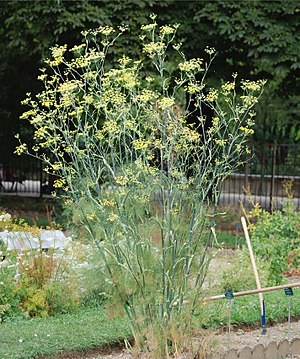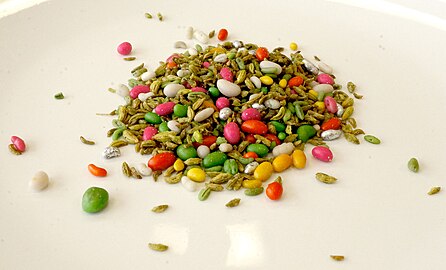フェンネル
Fennel/ja
| Fennel/ja | |
|---|---|

| |
| 花のフェンネル | |
| Scientific classification | |
| Kingdom: | Plantae |
| Clade: | Tracheophytes |
| Clade: | Angiosperms |
| Clade: | Eudicots |
| Clade: | Asterids |
| Order: | Apiales |
| Family: | Apiaceae |
| Genus: | Foeniculum |
| Species: | vulgare
|
| Binomial name | |
| vulgare | |
| Synonyms | |
|
List
| |
フェンネル(Foeniculum vulgare)は、セリ科の顕花植物の一種である。丈夫な耐寒性の多年生ハーブで、黄色の花と羽毛のような葉を持つ。地中海沿岸が原産であるが、世界の多くの地域、特に海沿いの乾燥した土壌や川岸に広く帰化している。
これは料理に使われる非常に風味豊かなハーブで、同様の味を持つアニスとともに、アブサンの主要な材料の一つである。フローレンスフェンネルまたはフィノッキオ(UK: /fɪˈnɒkioʊ/、US: /-ˈnoʊk-/、it)は、膨らんだ球根状の茎の根元(時に「球根フェンネル」と呼ばれる)を持つ品種で、野菜として使われる。
形態
フェンネル(Foeniculum vulgare)は多年生のハーブである。茎は中空で直立し、灰白色を帯びた緑色で、高さは最大2.1メートルに達する。葉は長さ40センチメートルまで成長し、細かく裂けており、最終的な裂片は糸状で、幅は約0.5ミリメートルである。その葉はディルの葉に似るが、より細い。
花は、幅5〜17.5センチメートルの頂生複合散形花序に形成され、各散形花序には短い花柄に20〜50個の小さな黄色の花がつく。果実は長さ4〜10ミリメートル、幅はその半分以下で溝のある乾燥した分離果である。果実内の種子は果皮に付着しているため、果実全体が「種子」と誤って呼ばれることが多い。
-
フローレンスフェンネルの球根
-
花序
-
散形花序
-
果実
-
『Köhler's Medicinal Plants』(1887年)より
成分
フェンネルの果実の芳香性は、様々な香りを放つ揮発性油に由来する。これには、トランス-アネトールやエストラゴール(リコリスに似る)、フェンコン(ミントやカンファー)、リモネン、1-オクテン-3-オール(キノコ)などが含まれる。フェンネルの果実に見られる他の植物化学物質には、ポリフェノールであるロスマリン酸やルテオリンなどが少量含まれる。
類似種
セリ科の一部の植物は有毒であり、識別が難しいことが多い。
ディル、コリアンダー、アジョワン、キャラウェイは見た目が似ているハーブだが、フェンネルより丈が低く、40〜60センチメートルにしかならない。ディルには糸状の羽毛のような葉と黄色の花がある。コリアンダーとキャラウェイには白い花と細かく裂けた葉がある(ただし、ディルやフェンネルほど細かくはない)。また、これらは寿命も短い(一年草または二年草)。これらの種子間の表面的な類似性は、キャラウェイの別名であるメリディアンフェンネルのように、名前や語源の共有につながった可能性がある。
ジャイアントフェンネル(Ferula communis)は、地中海地方に自生し、他の地域ではごくまれに庭園で栽培される、刺激的な香りを持つ大きくて粗い植物である。Ferula属の他の種もジャイアントフェンネルと呼ばれるが、これらは料理用ハーブではない。
北米では、フェンネルが同じ生息地で、パセリ科の有用な薬用植物である在来種のオシャ(Ligusticum porteri)やLomatium種とともに生育しているのが見られることがある。
ほとんどのLomatium種はフェンネルのような黄色の花を咲かせるが、一部は白い花を咲かせ、ドクゼリに似ている。Lomatiumは「ビスケットルート」として知られるアメリカ先住民の重要な歴史的食料植物である。ほとんどのLomatium種は細かく裂けた毛のような葉を持つ。その根はドクゼリのカビ臭い匂いとは異なり、繊細な米のような匂いがする。Lomatium種は、有機物のない乾燥した岩だらけの土壌を好む。
語源
「フェンネル」は古フランス語のfenoilから古英語に入り、それはさらにラテン語のfaeniculumに由来する。この語は「干し草」を意味するfaenumの指小辞である。
栽培

フェンネルは、その食用となる風味豊かな葉と果実のために、自生地およびその他の地域で広く栽培されている。そのアニスまたはリコリスのような風味は、アニスやスターアニスにも含まれる芳香化合物であるアネトールに由来しており、その味と香りはそれらに似ているが、通常はそれほど強くはない。
フローレンスフェンネル(Foeniculum vulgare Azoricum Group; シノニム F. vulgare var. azoricum)は、球根状の構造を形成する膨らんだ葉の基部を持つ栽培品種群である。これは栽培起源であり、穏やかなアニスのような風味を持つが、より甘く芳香がある。フローレンスフェンネルの植物は野生種よりも小さい。フローレンスフェンネルのいくつかの栽培品種は、特にイタリア語名finocchioなど、いくつかの他の名前でも知られている。北米のスーパーマーケットでは、「アニス」と誤表示されていることが多い。
Foeniculum vulgare 'Purpureum' または 'Nigra'、「ブロンズ葉フェンネル」は、装飾的な庭園植物として広く入手可能である。
フェンネルは、北ヨーロッパ、米国、カナダ南部、アジアの大部分、オーストラリアなど、多くの地域の道端、牧草地、その他の開けた場所で帰化している。根冠と種子の両方でよく繁殖し、オーストラリアと米国では外来種および雑草と見なされている。フェンネルは、草地、海岸の低木地、河畔、湿地の群落など、多くの植物群落の構成と構造を劇的に変化させる可能性がある。これは、光、栄養素、水について在来種を凌駕することで、またおそらく他の植物の成長を阻害するアレロパシー物質を分泌することによってこれを行っているようである。北米西部では、フェンネルは海岸および内陸のワイルドランド・アーバン・インターフェースから東に丘陵地や山岳地帯まで見られるが、砂漠の生息地には見られない。例えば、サンタクルーズ島(カリフォルニア州)では、フェンネルが50〜90%の絶対被覆率を達成している。
生産
国際連合食糧農業機関によって分類されているように、フェンネルの生産データは、アニス、スターアニス、コリアンダーといった類似のスパイスと合わせて集計されている。2014年には、インドが世界のフェンネル生産量の60%を占め、中国とブルガリアが主要な二次生産国であった。
| 国 | 生産 (トン) |
|---|---|
| 584,000 | |
| 48,002 | |
| 36,500 | |
| 32,771 | |
| 29,251 | |
| 27,668 | |
| World | 970,404 |
| この情報は、国連の統計データベースであるFAOSTATから取得されたもので、フェンネルの生産データが、アニス、スターアニス、コリアンダーといった関連スパイスとまとめて集計されていることを示している。 | |
Uses
Fennel was prized by the ancient Greeks and Romans, who used it as medicine, food, and insect repellent. Fennel tea was believed to give courage to warriors before battle. According to Greek mythology, Prometheus used a giant stalk of fennel to carry fire from Mount Olympus to Earth. Emperor Charlemagne required the cultivation of fennel on all imperial farms.
Florence fennel is one of the three main herbs used in the preparation of absinthe, an alcoholic mixture which originated as a medicinal elixir in Europe and became, by the late 19th century, a popular alcoholic drink in France and other countries. Fennel is also featured in the Chinese Materia Medica for its medicinal functions.
A 2016 study found F. vulgare essential oil to have insecticidal properties.
Nutrition
| Nutritional value per 100 g (3.5 oz) | |||||||||||||||||||||||||||||||||||||||
|---|---|---|---|---|---|---|---|---|---|---|---|---|---|---|---|---|---|---|---|---|---|---|---|---|---|---|---|---|---|---|---|---|---|---|---|---|---|---|---|
| Energy | 1,443 kJ (345 kcal) | ||||||||||||||||||||||||||||||||||||||
52 g | |||||||||||||||||||||||||||||||||||||||
| Dietary fiber | 40 g | ||||||||||||||||||||||||||||||||||||||
14.9 g | |||||||||||||||||||||||||||||||||||||||
| Saturated | 0.5 g | ||||||||||||||||||||||||||||||||||||||
| Monounsaturated | 9.9 g | ||||||||||||||||||||||||||||||||||||||
| Polyunsaturated | 1.7 g | ||||||||||||||||||||||||||||||||||||||
15.8 g | |||||||||||||||||||||||||||||||||||||||
| |||||||||||||||||||||||||||||||||||||||
| Other constituents | Quantity | ||||||||||||||||||||||||||||||||||||||
| Water | 8.8 g | ||||||||||||||||||||||||||||||||||||||
| †Percentages estimated using US recommendations for adults, except for potassium, which is estimated based on expert recommendation from the National Academies. | |||||||||||||||||||||||||||||||||||||||
A raw fennel bulb is 90% water, 1% protein, 7% carbohydrates, and contains negligible fat.
Dried fennel seeds are typically used as a spice in minute quantities. A reference amount of 100 grams (3.5 oz) of fennel seeds provides 1,440 kilojoules (345 kilocalories) of food energy and is a rich source (20% or more of the Daily Value, DV) of protein, dietary fiber, B vitamins and several dietary minerals, especially calcium, iron, magnesium and manganese, all of which exceed 90% DV. Fennel seeds are 52% carbohydrates (including 40% dietary fiber), 15% fat, 16% protein, and 9% water.
Cuisine
The bulb, foliage, and fruits of the fennel plant are used in many of the culinary traditions of the world. The small flowers of wild fennel (known as fennel "pollen") are the most potent form of fennel, but also the most expensive. Dried fennel fruit is an aromatic, anise-flavored spice, brown or green when fresh, slowly turning a dull grey as the fruit ages. For cooking, green fruits are optimal. The leaves are delicately flavored and similar in shape to dill. The bulb is a crisp vegetable that can be sautéed, stewed, braised, grilled, or eaten raw. Tender young leaves are used for garnishes, as a salad, to add flavor to salads, to flavor sauces to be served with puddings, and in soups and fish sauce. Both the inflated leaf bases and the tender young shoots can be eaten like celery.
Fennel fruits are sometimes confused with those of anise, which are similar in taste and appearance, though smaller. Fennel is also a flavoring in some natural toothpastes. The fruits are used in cookery and sweet desserts.
Many cultures in India, Afghanistan, Iran, and the Middle East use fennel fruits in cooking. In Iraq, fennel seeds are used as an ingredient in nigella-flavored breads. It is one of the most important spices in Kashmiri cuisine and Gujarati cooking. In Indian cuisine, whole fennel seeds and fennel powder are used as a spice in various sweet and savory dishes. It is an essential ingredient in the Assamese/Bengali/Oriya spice mixture panch phoron and in Chinese five-spice powders. In many parts of India, roasted fennel fruits are consumed as mukhwas, an after-meal digestive and breath freshener (saunf), or candied as comfit. Fennel seeds are also often used as an ingredient in paan, a breath freshener most popularly consumed in India. In China, fennel stem and leaves are often ingredients in the stuffings of jiaozi, baozi, or pies, as well in cold dishes as a green vegetable. Fennel fruits are present in well-known mixed spices such as the five-spice powder or thirteen-spice powder.
Fennel leaves are used in some parts of India as leafy green vegetables either by themselves or mixed with other vegetables, cooked to be served and consumed as part of a meal. In Syria and Lebanon, the young leaves are used to make a special kind of egg omelette (along with onions and flour) called ijjeh.
Many egg, fish, and other dishes employ fresh or dried fennel leaves. Florence fennel is a key ingredient in some Italian salads, or it can be braised and served as a warm side dish. It may be blanched or marinated, or cooked in risotto.
Fennel fruits are the primary flavor component in Italian sausage. In Spain, the stems of the fennel plant are used in the preparation of pickled eggplants, berenjenas de Almagro. A herbal tea or tisane can also be made from fennel.
On account of its aromatic properties, fennel fruit forms one of the ingredients of the well-known compound liquorice powder. In the Indian subcontinent, fennel fruits are eaten raw, sometimes with a sweetener.
-
Sugar-coated and uncoated fennel fruits used as a breath freshener
-
Indian mukhwas (breath freshener) made of fennel seeds and rock sugar
-
Chinese bing with fennel filling
Culture
The Greek name for fennel is marathon (μάραθον) or marathos (μάραθος), and the place of the famous battle of Marathon literally means a plain with fennel. The word is first attested in Mycenaean Linear B form as ma-ra-tu-wo. In Hesiod's Theogony, Prometheus steals the ember of fire from the gods in a hollow fennel stalk.
As Old English finule, fennel is one of the nine plants invoked in the pagan Anglo-Saxon Nine Herbs Charm, recorded in the 10th century.
In the 15th century, Portuguese settlers on Madeira noticed the abundance of wild fennel and used the Portuguese word funcho (fennel) and the suffix -al to form the name of a new town, Funchal.
Henry Wadsworth Longfellow's 1842 poem "The Goblet of Life" repeatedly refers to the plant and mentions its purported ability to strengthen eyesight:
Above the lower plants, it towers,
The Fennel with its yellow flowers;
And in an earlier age than ours
Was gifted with the wondrous powers
Lost vision to restore.
外部リンク
| この記事は、クリエイティブ・コモンズ・表示・継承ライセンス3.0のもとで公表されたウィキペディアの項目Fennel(22 May 2025, at 22:02編集記事参照)を翻訳して二次利用しています。 |








